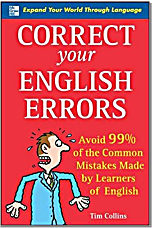
Avoid 99% of the Common Mistakes Made by Learners of English

| Book of the Month | ||
 |
Correct Your English Errors Avoid 99% of the Common Mistakes Made by Learners of English |
 |
Publisher: McGraw Hill
Author: Tim Collins
$15.78
ASIN: B01FODCM4Y3
Most people make occasional mistakes while writing English, and everybody makes mistakes while speaking. English is a very complicated language with many odd rules and even odder exceptions to those rules. EFL students have to be especially careful to avoid two particular types of error. The first type comes from faulty learning. For example the sentence, 'I putted the book back on the shelf' suggests that the student needs to spend more time working on irregular past tenses. The second type of error comes from using native language grammar in English. For example speakers of German often the verb at the end of the sentence put, instead of putting it before the object as English speakers tend to do. Speakers of languages which do not use articles tend to forget them in English also. ('Do you have pet dog?') This book aims to help speakers identify these errors and correct or avoid them.
The format is large paperback, so this book will fit into a rucksack, but not under a jacket. At 341 pages, it is also quite bulky. The book starts with a useful pre-test which helps users to establish their level of English competence and where errors are likely to occur in their language use. This is followed by a 30-page section which outlines the basic rules of pronunciation and spelling. The grammar description which follows is the standard type of text which can be found in any grammar book - explanations of nouns, adjectives, verbs, adverbs and so on. It is however worth paying attention here because the book uses technical grammatical explanations to describe types of error. For example, when talking about pronoun use, the book offers this explanation "'One' is an indefinite subject pronoun, 'oneself' is an indefinite reflexive pronoun." In other words, a reader who does not understand the language used to talk about grammar is going to struggle with this text - and that is particularly the case for those native speakers who are not taught these terms in school. It does not help that some errors at the elementary level are described with advanced level English.
The book then goes on to describe and highlight more than 1000 errors of different types. The text is not particularly dense, so there are some empty white spaces on some pages, and the book overall has an odd pink-and-white colour scheme which takes a bit of getting accustomed to. There are no illustrations. There are pink boxes throughout the book called 'Avoid the error' which are used to emphasize a particular problem. For example the book points out that many people say 'Dis' when they want to say 'this'. It also mentions that with English speech it is normal and acceptable to show your tongue when saying certain words, but people from cultures where this is not usually done might prefer to put a hand in front of their mouths until they become comfortable doing this.
The exercises are the usual type for EFL students. In some exercises students have to find the errors in a sentence and either correct the error or rewrite the sentence correctly. There is an answer key and an index at the back of the book. While the book is available in digital form (Kindle) there does not seem a classroom edition without the answer key. Note also that spelling is American English, though the pronunciation works just as well for British students.
Who is this book for? In a way the weakness of the book is that it is suitable for EFL students of all nationalities. This is a weakness because errors of pronunciation made by - for example, speakers of East Asian languages - are not the same types of error that Spanish language speakers make, and therefore different parts of the book are of little use to different students. However, the book is a useful way of learning grammar overall, because in learning where the mistakes are one has to also learn how to use grammar correctly.
Verdict: Verdict – Not all parts work for everybody
Assessment 7/10